"I think that Walter Schirra aboard Mercury 8 was the first of the astronauts to use the code name 'Santa Claus' to indicate the presence of flying saucers next to space capsules." -Maurice Chatelain
Well, here we are: December 25th, Christmas day, here at Starts With A Bang! Whether you're a Santa, a Scrooge or anywhere in between when it comes to the generosity of your holiday spirit, I've got some good things for you. First, there's a brand new Starts With A Bang podcast for you to enjoy, on whether our Universe itself could be the inside of a black hole.
- What's the deal with the speed of light? (for Ask Ethan),
- This is what it looks like when a Sun dies (for Mostly Mute Monday),
- 5 scientific myths you probably believe about the Universe,
- New evidence threatens to crush the dreams of alien megastructures,
- Why measuring antimatter is the key to our Universe, and
- Water in space: does it freeze or boil?
Good stuff, if I do say so myself. And now, your Christmas comments of the week!
From Omega Centauri on science, policy and communication: "Do we upfront acknowledge all the counter intuitive exceptions to the general rule, at the risk of boring people or obscuring the message, or do we leave those in an appendix that will only be read by the few most motivators reader? These sorts of things come up not just in climate change, but in many other areas where science and policy collide. And I don’t think there is any clear answer about how to handle them."
Everyone has their own opinion on this, and because how to communicate science is itself an artform, not a science, there isn't really a clear 'follow-this-formula-for-optimal-results' equation out there. My view on science literacy -- or even my definition of science literacy -- isn't the mainstream one, although it is rooted in a significant amount of evidence.
- I don't think giving everybody the full suite of facts and just laying them out is effective, because people pick and choose which facts they remember to support their own position.
- I don't think belaboring the gory details and the exceptions are generally worthwhile, because highlighting the nuance, in general, means the overall message gets lost.
- And I don't think that aspiring that everyone be able to perform the scientific analysis themselves is a useful task; most people seek only to convince themselves, not to draw a valid scientific conclusion.
I think the best path to science literacy -- and this follows the scholarly work of Morris Shamos (RIP), which you can get for a penny on amazon.com -- is to teach people an awareness of what the scientific enterprise is and to give them an appreciation for what science knows and does as a result. You can give them more or fewer details as you like, but that should be the main message. Anything more than that is going above and beyond what's required, but that's what I choose to look for. It's sort of in the same vein as Star Trek.
 Three members of the Star Trek crew beaming down off the ship. Image credit: CBS Photo Archive/Getty Images.
Three members of the Star Trek crew beaming down off the ship. Image credit: CBS Photo Archive/Getty Images.
Star Trek brought us a glorious future, where advances in science and technology were used for the benefit of all members of all planets in the Federation, by picturing scientists as altruists. Rather than warmongers who brought us progressively more destructive weapons, scientists were researchers who sought out truth, knowledge, and positive applications towards the ends of peace and societal advancement. Many people don't see scientists in this same light, but that's what we're doing; that's what we're striving for. We're on the side of humanity. We have value. What we do and what we learn has value. All we're asking -- and yes, perhaps demanding -- is that we all actually value it.
Gravity is the type of law I definitely get. Constitutional law, not as much. Image credit: © Copyright 2016 ME - Mechanical Engineering, via http://me-mechanicalengineering.com/newtons-laws-of-motion/.
From Narad on constitutional law: "I’ll just leave this here."
Popehat is a pretty good site in general for explanations about the law that go beyond what you'd simply get by reading the constitution for yourself and applying a reasonable standard to it. I am not an expert in all things, and the law is certainly one of the ones I'm a non-expert in.
 No matter its color, wavelength or energy, the speed at which light travels in a vacuum is always the same. This is independent of positions or directions in space and time. Public domain image.
No matter its color, wavelength or energy, the speed at which light travels in a vacuum is always the same. This is independent of positions or directions in space and time. Public domain image.
From Mike Doonesbury on the speed of light: "If you got into a Ford Mustang and accelerated at 1 G for seven months and then integrated your speedometer, you would calculate a velocity greater than the speed of light. The reason you can do this is the Principal (sic) of Relativity, which states, briefly, that you can perform no experiment that will tell you how fast you’re going."
That's not quite what the principle of relativity tells us, though. It tells us that to observers in all reference frames, light will appear to move at the same universal speed: 299,792,458 m/s. It's true that you can never calculate your velocity relative to empty space, because there is no such thing as absolute, empty space, but you can calculate it relative to the Chevy Nova you're passing, any matter particles or even the rest frame of the CMB. You'll never, under any measurement circumstances, calculate yourself moving faster than the speed of light. Adding up an extra "+9.8 m/s" for each second you go by is a calculation that you might be tempted to make, but that special relativity tells you is wrong.
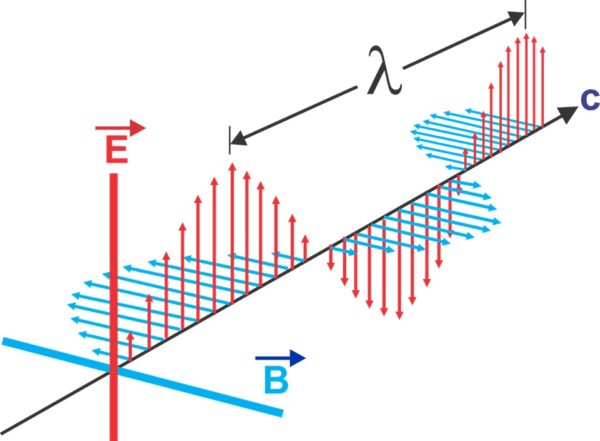 The oscillating, in-phase electric and magnetic fields propagating at the speed of light define electromagnetic radiation. Public domain image.
The oscillating, in-phase electric and magnetic fields propagating at the speed of light define electromagnetic radiation. Public domain image.
From David on a common misconception about the energy stored in light waves: "Aren’t the E and B fields in a traveling light wave out-of-phase, so that the energy density E.dot.E + B.dot.B remains constant?"
You might think so, but that's not how it works. The "E.dot.E + B.dot.B" remains constant when you consider that these are complex fields; we're only seeing the real components of them. Alternatively, I also like Michael Kelsey's explanation.
That’s what you might think (each field’s time rate of change drives the other), but that isn’t the case.
If you combine Maxwell’s zero-source equations (i.e., the two curl relationships with no charges and no currents), what you get is a relation between the time derivative of one and the space derivatives of the other. The net result is that the two fields are in phase.
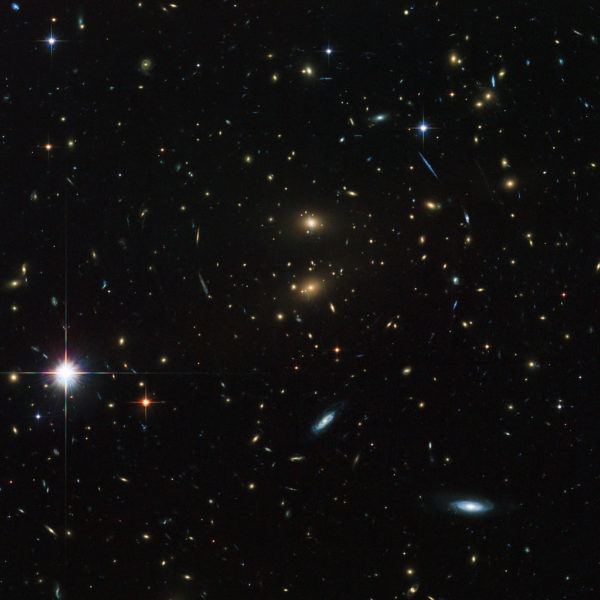 Galaxy cluster LCDCS-0829, as observed by the Hubble Space Telescope. This galaxy cluster is speeding away from us, and in only a few billion years will become unreachable, even at the speed of light. Image credit: ESA/Hubble & NASA.
Galaxy cluster LCDCS-0829, as observed by the Hubble Space Telescope. This galaxy cluster is speeding away from us, and in only a few billion years will become unreachable, even at the speed of light. Image credit: ESA/Hubble & NASA.
From Sinisa Lazarek on a new theory of creation: "maybe it was a failed experiment.. excited the inflaton field in the wrong way and woooosh. ? this is all just an afterglow"
Come on, Shiva the destroyer, you had one job!
Four individual planetary nebulae -- He 2-47, NGC 5315, IC 4593, and NGC 5307 -- were imaged by Hubble in February of 2007. Image credit: NASA, ESA, and The Hubble Heritage Team (STScI/AURA).
From PJ on the planetary nebulae showcased on last week's Mostly Mute Monday: "Absolutely spectacular ! It’s sometimes hard to get a handle on how much energy is expended in each of the photo’s.
Have a safe holiday, you lot. Back in a few weeks."
Of course everyone should have a happy holiday season, regardless of what (or whether) you believe in anything natural or supernatural at all. The comments section here is great evidence that we come from all over the world, and are of many different ages, education levels, political beliefs and ideologies. But for some reason or other, we all enjoy sharing in components of the story of this Universe, and that makes what we have here something rather special.
But for PJ, this is the best time of the year for being outside and enjoying a summer vacation. The fact that the darkest days of the Northern Hemisphere's year coincide with the start of Australian summer may explain why I always see so few aussies (excepting transplants) at the annual AAS meeting the first week in January!
An illustration of how redshifts work in the expanding Universe. Image credit: Larry McNish of RASC Calgary Center, via http://calgary.rasc.ca/redshift.htm.
From Michael Kelsey on distances in the expanding Universe: "The “46 billion light years” you are explaining is the “comoving distance” (type that into Wikipedia!) between us and the CMB (surface of last scattering; type that into Wikipedia as well). That is, how far away is an object TODAY, if it emitted the light we see 13.8 billion years ago. But what we see is the light from 13.8 billion years ago, and at that time that same “object” was much, MUCH, closer to us than it is now.
So do we want to talk about the comoving distance, or the light transit time, or the original emission distance? Those are three entirely different quantities, and mixing them will lead to nothing but trouble."
This is a very important point that I think needs highlighting. When we talk about distances in the expanding Universe, there are three things you might think of:
- How far away this object was from us when it emits the light we now detect.
- How far away the object is from us "right now," if we could somehow travel at infinite speed to this object and measure the distance we traversed.
- How far the light -- arriving right now -- traveled from this object to our eye along its journey.
For objects close by, like within our own galaxy or local group, all three of these numbers are generally pretty close to identical. But for objects that are very distant, whose light we see from very long ago, the three definitions lead to very different numbers.
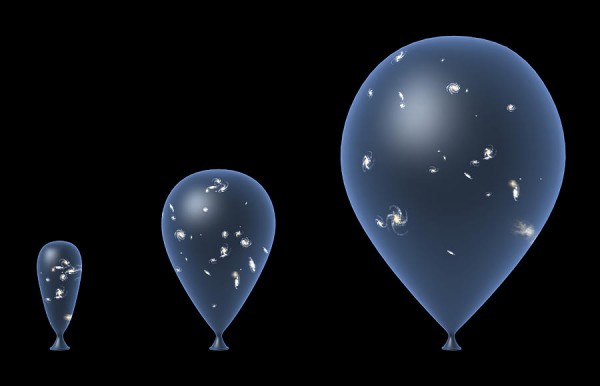 Image credit: Science Photo Library / Take 27 Ltd, via http://fineartamerica.com/.
Image credit: Science Photo Library / Take 27 Ltd, via http://fineartamerica.com/.
In the very distant past, everything was much, much closer together. The Universe has expanded, and light has always traveled at the speed of light. If you were to use the first definition to measure the earliest galaxy we've ever seen -- from 13.4 billion years ago, or 0.4 billion years after the Big Bang -- you would find it's only about 1 billion light years away. The Universe has expanded by that much. If you were to use the second definition, which is the one I tend to use, you would get about 30 billion light years. And if you were to use the third definition, you'd get 13.4 billion light years by definition: the light travel time. (Some NASA press releases use this definition.) At least you've got the information now, in case you're interested.
Shake: 'Here, read this book.'
Meatwad: 'Do not use in microwave oven.'
Image credit: Adult Swim/Aqua Teen Hunger Force.From axil on microwave ovens and new fundamental physics: "One way to test this theory, is to demonstrate the reduction of the half life of an radioactive isotope in the regions of positive vacuum energy against the result produce in the regions of negative vacuum energy. The positive vacuum energy should produce a reduction in the half life in the radioactive isotope."
Nice hypothesis you've got there. What were the results of your test? This seems like an easy one to:
- write down your methods.
- perform the experiment vs. a control (no microwave).
- measure your results.
- publish your conclusions.
It's easy to report, "someone claims this thing is happening," that's pretty much all of what I've ever seen with LENR and the EMdrive. Now you have a new claim that contradicts the predictions of fundamental physics, and you claim it's easy to test. What are the results? (If you don't have them, you haven't done science yet, BTW.)
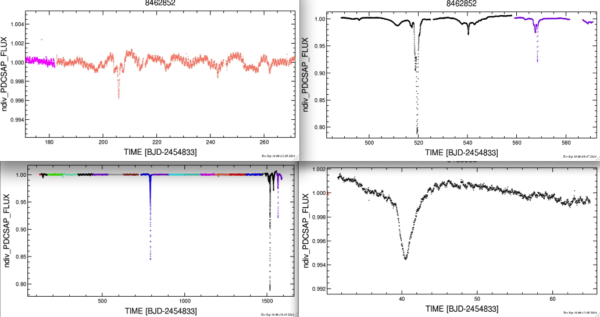 Image credit: Tabby Boyajian and her team of PlanetHunters, via http://sites.psu.edu/astrowright/2015/10/15/kic-8462852wheres-the-flux/.
Image credit: Tabby Boyajian and her team of PlanetHunters, via http://sites.psu.edu/astrowright/2015/10/15/kic-8462852wheres-the-flux/.
From Sinisa Lazarek on Tabby's star and its uniquely odd behavior: "If you take into account that Tabby’s star was/is dimming at an incredible rate for the last hundred or so years. And then these dips that sometimes go as much as 20% of the brightness… and I had to extrapolate a hypothesis… I would say that the star is somehow dying. But totally unlike anything we know.
I’m almost thinking about something that could be inhibiting fusion from the inside. What if it’s not the light getting blocked by something, but the [star] itself getting “buggy”."
The dimming is sketchy, to say the least. Over the 100+ years its been measured, it may have dimmed overall (gone to higher visual magnitude numbers), but it hasn't been at a consistent rate. These observations are... questionable in their robustness. Have a look at the results directly from the 2016 paper.
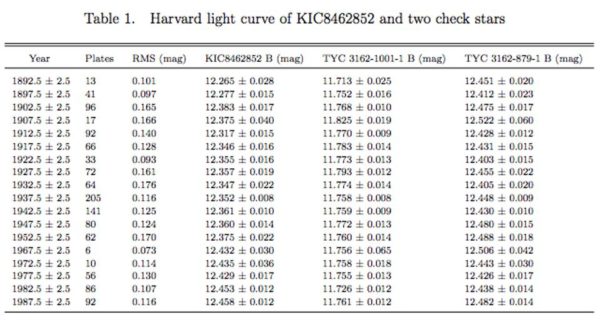 The dimming of Tabby's star, KIC 8462852. Image credit: Bradley E. Schaefer, via http://arxiv.org/abs/1601.03256.
The dimming of Tabby's star, KIC 8462852. Image credit: Bradley E. Schaefer, via http://arxiv.org/abs/1601.03256.
If you throw out the observations from the 1800s, things look pretty constant from 1900 to 1970, and then they look pretty constant again from 1970 to the present. So I'm not sure that this is real.
An F-class star this young -- a few hundred million years old -- shouldn't be dying. It should be steady and on the main sequence. Internal variations in the fusion rate couldn't cause such rapid variability at the surface; heat transport from the core to the surface takes tens of thousands of years. Something funny is going on for sure, but the intrinsic explanations that can't immediately be ruled out are hard to come by.
The CMS detector, prior to its final installation. Image credit: CERN/Maximlien Brice, of the CMS detector, the small detector at the LHC.
From Michael Kelsey on particle physics detectors: "a very minor nitpick. Bubble chamber tracks alone cannot determine all the properties of particles, not without significant assumptions (and thereby fairly large uncertainties). In fact, there’s no kind of detector which directly measures the mass of any subatomic particle. That’s always _inferred_ from the relationships between measurables like momentum, energy, or velocity."
And this underscores the importance of having such a sophisticated detector. You can measure energy and momentum from calorimeters placed outside the collision point: E-cals and k-cals. That enables you to reconstruct the mass. You can measure electric charge by applying a magnetic field and seeing how the particles -- of given energies and momenta -- bend. You can measure a particle's lifetime by either the distance to a displaced vertex or the speed/distance it travels in the chamber/detector. And the reason CMS and ATLAS are so ginormous is because muons live so long and are so low in mass; if you want to detect them accurately, the detectors need to be that large.
It's been a while since my graduate particle physics, and even longer (1997! yeesh!) since I worked in experimental particle physics as an undergrad, so I may gloss over things or get sloppy about them from time to time. Thanks for making sure we get it right in the end, particularly for the sophisticated audience we have here!
Pair production and matter-antimatter annihilation. Image credit: Addison-Wesley, retrieved from J. Imamura / U. of Oregon.
And finally, for the last word this Christmas, we have a scenario worth exploring from Denier: "
1 – If matter touches anti-matter in space the two pieces annihilate into energy.
2 – Time is just a dimension in space-time. It is all the same stuff, just in a different direction.
3 – Neutrinos are their own anti-particle and can flavor change between anti-matter neutrinos and matter neutrinos.
Why does a matter to anti-matter flip not instantly cause the neutrino to annihilate? It its timeline the matter neutrino is touching the anti-matter neutrino."
If neutrinos are majorana particles, and are their own antiparticles, then this is a legitimate question. In fact, even if that third part of the question is false, the Cosmic Neutrino Background is made up of equal parts neutrinos and antineutrinos, to the tune of about 300 neutrinos per cubic centimeter permeating all of space around us. And it's true, that if matter "touches" antimatter in space, they annihilate into pure energy. But "touching" has a particular meaning in physics, and is dependent on cross-section. For neutrinos (and antineutrinos), that cross section is not only tiny, it gets smaller at lower energies.
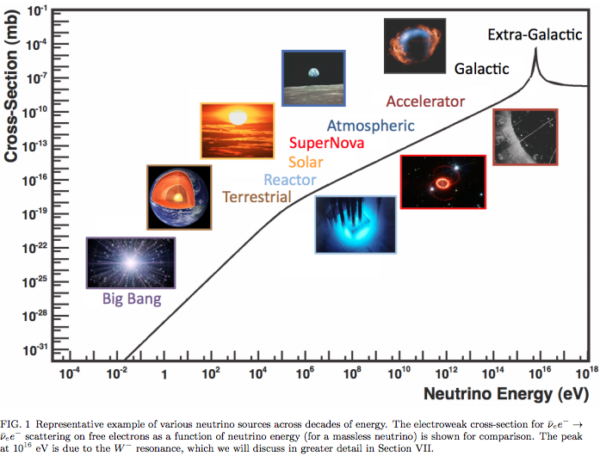 The neutrino cross section with electrons/positrons. Image credit: J.A. Formaggio and G.P. Zeller, via https://arxiv.org/abs/1305.7513.
The neutrino cross section with electrons/positrons. Image credit: J.A. Formaggio and G.P. Zeller, via https://arxiv.org/abs/1305.7513.
A neutrino-antineutrino interaction could produce any number of particles, but we have never observed one because the cross section is so tiny. The simple answer to your question is that neutrinos and antineutrinos don't "touch" very frequently. Dark matter particles, in most models, are their own antiparticles as well, but we don't see a mysterious radiation excess that we can attribute to them. If you interact through the strong or electromagnetic force, you're easy to detect this way, as "touching" happens all the time. But if not, it's like you don't even touch at all.
Thanks for a great week and a great year! We'll have plenty of wonderful stories this coming week and then it's off to AAS in January to bring you the greatest Astronomy news to start off 2017. Thanks for sharing a bit of your world with me, and I'll see you back here soon!


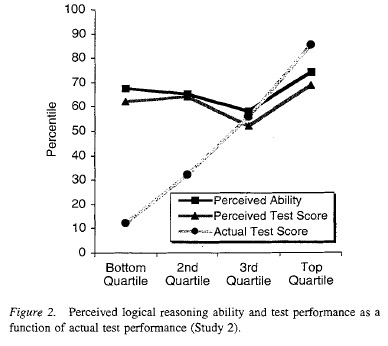
@ Ethan re: Tabby's star
Thank you for addressing it. The overall century dimming I got from this paper which is linked on wiki. https://arxiv.org/abs/1601.03256
Am not skilled to judge anyone's findings on this matter. But agree with you that when looking at the magnitude measurements you posted, it's far less apparent or true.
Didn't know about the time it would take for the effects to propagate to the surface. Thank you :) Darn...it's now even a a bigger mystery :)
Here I reference again one of a dozen experiments showing how the half life of a radioactive isotope can be affected by EMF simulation of nanoparticles.
Specifically, I reference a paper here to show how the nanoplasmonic mechanism can change the half-life of U232 from 69 years to 6 microseconds. It also causes thorium to fission.
See references:
http://www.google.com/url?sa=t&rct=j&q=&esrc=s&frm=1&source=web&cd=1&ca…
Other experiments of like method can be found here
A comment on the The Andreev paper
docviewer.yandex.com/?url=ya-d…5%D0%B9%D0%BD%D0%BE%D0%B5%D1%82%D1%83%D1%88%D0%B5%D0%BD%D0%B8%D0%B5 Cs-137_%D1%81%D0%B5%D0%BC%D0%B8%D0%BD%D0%B0%D1%80 %D0%A0%D0%A3%D0%94%D0%9D 24_11_2016.pdf&c=58387351efa1
using laser ablation for quenching the radioactivity of Cs-137.
Using laser light conversion to a coherent magnetic field through the interaction of coherent laser photons and gold nanoparticles shows how the LENR reaction works.
The LENR reaction is mediated by an amplified weak force. The production of a coherent magnetic field through the use of laser light irradiating gold nanoparticles greatly strengthens the weak force.
LENR is a consequence of the amplified strength levels of the weak force that existed at the beginning of the cosmos where it reaches grand unification strength levels. At these immense levels of strength, protons and neutrons decay into strange matter mesons.
A.V. Simakin has also produced a full range of laser based irradiation of gold nanoparticle experiments that show accelerated weak force activity including stabilization of radioactive isotopes, fusion and fission.
see
scirate.com/search?q=au:Simakin_A+in:physics
A.I. Laptukhov "The possible mechanism of the quenching of the radioactivity of the isotope Cs137
https://yadi.sk/i/S9xc1QR-ze6wP
Among other things, this paper remarks about the steady production of gamma radiation even when the rate of stabilization of the isotope CS137 is accelerated by some 1200 times the expected rate. The decay of Cs137 is an exothermic process; excess energy would be expected to be generated from the conversion of the unstable isotope to the stable daughter decay product.
Where does all that energy produced by the stabilization of the isotope go?
At the most basic level, I have always expected that LENR is a result of a single foundational mechanism, namely the accelerated action of the weak force under the catalytic effect of quantum coherence.
I found another interesting experiment that G.A. Shafeev collaborated in that was not included in the list that I referenced above.
Laser-induced synthesis and decay of Tritium under exposure of solid targets in heavy water
https://arxiv.org/ftp/arxiv/papers/1306/1306.0830.pdf
Other systems using laser irradiation of various transition metal nanostructures show both the formation of tritium and its rapid decay as a simultaneous operation.
I like these laser based experiments that reveal in the most basic terms what is happening in the bare bones LENR reaction.
----------------------------------------------------------------------------------
Here is a post that I just wrote relating to the reference that I am giving to you now.
Superconductivity is central to the LENR reaction because it brings coherence as an indispensable catalytic factor to the LENR reaction.
The LENR reaction is produced by a greatly amplified weak force interaction with matter that destabilizes nuclear matter through coherence.
Particle physics is based on finding supersymmetry to complete the standard model. Not finding proton decay would mean that the standard model was wrong.
To produce proton decay through coherence, it is important to find the conditions where non equilibrium high temperature superconductivity persists at high temperatures up to 7000K where some instances of the LENR reaction have been observed.
In this system, an interesting observation about how the weak force is operating in LENR
http://www.newinflow.ru/pdf/Klimov_Poster.pdf
[quote]Spectrometer X-123SDD records soft X radiation (0.1 - 30 keV) in heterogeneous plasmoid. X-receiver is arranged at different cross sections of PVR testing section and cross sections behind nozzle at L = 1 ÷ 100 cm from it.
• Heterogeneous plasmoid behind PVR nozzle is γ-radioactive. Soft X-radiation 100 - 10000 eV from this plasmoid. X-radiation decrement is very small (radiation intensity decrease is about 20% at L = 100 cm)[/quote]
At the very tip of the reaction nozzle, there is gamma radiation produced by the weak force decay. But over a very short time as the plasma moves away from the reaction nozzle at supersonic speeds, even though the reaction temperature is initially 7000K or more, the level of radiation is reduced in stages until at L = 100cm, the x-ray energy level is nominal at 30 keV. This nominal 30 keV x-ray level is the level reported by Defkalion in their system using spark discharge.
Other systems using laser irradiation of various transition metal nanostructures show both the formation of tritium and its rapid decay as a simultaneous operation. The laser brings coherence to the LENR reaction as a catalyst for weak force amplification.
See
https://arxiv.org/ftp/arxiv/papers/1306/1306.0830.pdf
[quote]Tritium is another unstable isotope with half-life of 12.2 years. It would be interesting to induce its beta-decay by exposure to laser radiation, as it was done previously for other nuclides. In this work we demonstrate for the first time the nuclear synthesis and decay of Tritium under laser exposure of various targets in D2O.
[/quote]
I like these laser based experiments that reveal in the most basic terms what is happening in the bare bones LENR reaction.
The best of regards and a happy new year.
I think Christmas say is as good a day as any, perhaps better than many, to reflect on the iniquities of scientific funding. This poem speaks to the heart of the split between 'big-money fusion' and the 'pocket-change nuclear' that many of lesser order are interested in.
Take Away Your Billion Dollars. Arthur Roberts
1. Upon the lawns of Washington the physicists assemble,From all the land are men at hand, their wisdom to exchange.
A great man stands to speak, and with applause the rafters tremble."My friends," says he, "you all can see that physics now must change.
Now in my lab we had our plans, but these we'll now expand,Research right now is useless, we have come to understand.
We now propose constructing at an ancient Army base,The best electronuclear machine in any place.
2. It will cost a billion dollars, ten billion volts 'twill give, It will take five thousand scholars seven years to make it live.
All the generals approve it, all the money's now in hand, And to help advance our program, teaching students now we've banned.
We have chartered transportation, we'll provide a weekly dance, Our motto's integration, there is nothing left to chance.
This machine is just a model for a bigger one, of course, That's the future road for physics, as I hope you'll all endorse."
3. And as the halls with cheers resound and praises fill the air,One single man remains aloof and silent in his chair.
And when the room is quiet and the crowd has ceased to cheer,He rises up and thunders forth an answer loud and clear.
"It seems that I'm a failure, just a piddling dilettante,Within six months a mere ten thousand bucks is all I've spent.
With love and string and sealing wax was physics kept alive,Let not the wealth of Midas hide the goal for which we strive."
4. "Take away your billion dollars, take away your tainted gold, You can keep your damn ten billion volts, my soul will not be sold.
Take away your army generals; their kiss is death, I'm sure. Everything I build is mine, and every volt I make is pure.
Take away your integration; let us learn and let us teach, Oh, beware this epidemic Berkelitis, I beseech.
Oh, dammit! Engineering isn't physics, is that plain? Take, oh take, your billion dollars, let's be physicists again."
This U.S. Navy patent transmutes radioactive elements into less harmful elements through a benign “cold fusion” low energy nuclear reaction process. The patent was granted April 16, 2013 for a device and method that shortens the half-life of radioactive materials by increasing their rate of emissions. The process creates high pressure steam for the turbines eliminating the need for refueling of existing nuclear reactor cores.
https://www.google.com/patents/US8419919
System and Method for Generating Particles – US8419919 B1
United States Navy Patent
Cold Fusion LENR Energy
Publication number – US8419919 B1
Publication type – Grant
Application number – 11/859,499
Publication date – Apr 16, 2013
Filing date – Sep 21, 2007
Inventors
Pamela A. Boss
Frank E. Gordon
Stanislaw Szpak
Lawrence Parker Galloway Forsley
Original Assignee
The United States Of America As Represented By The Secretary Of The Navy
And Jwk International Corporation – see (wikicorp) or (company link)
DETAILED DESCRIPTION OF SOME EMBODIMENTS
Particles are generated from the application of method. As used herein, the term “generated” is used to refer to the forming of particles through a process involving chemical and, depending upon the substrate, magnetic interaction.
Examples of the types of particles generated and detected may include, but are not limited to: alpha particles, beta particles, gamma rays, energetic protons, deuterons, tritons, and neutrons. The particles generated by the implementations of method may have various applications.
For example, the generated particles may be captured by other nuclei to create new elements, may be used to remediate nuclear waste, may be used to create strategic materials, or may be used to treat cancerous tumors.
As an example there are some sites that have groundwater that is contaminated with radionuclides, such as technetium, Tc-99. The particles emitted by electrochemical cell may be absorbed by the radionuclide, Tc-99 via neutron capture, transmuting it to Tc-100 with a half life of 15.8 seconds to Ru-100, which is stable where the reaction is shown by 99Tc43(n,γ)100Tc43 and the 100Tc43 β− decays to 100Ru44 with a half-life of 15.8 seconds.
From axil on microwave ovens and new fundamental physics: “One way to test this theory, is to demonstrate the reduction of the half life of an radioactive isotope in the regions of positive vacuum energy against the result produce in the regions of negative vacuum energy. The positive vacuum energy should produce a reduction in the half life in the radioactive isotope.”
Nice hypothesis you’ve got there. What were the results of your test? This seems like an easy one to:
write down your methods.
perform the experiment vs. a control (no microwave).
measure your results.
publish your conclusions.
It’s easy to report, “someone claims this thing is happening,” that’s pretty much all of what I’ve ever seen with LENR and the EMdrive. Now you have a new claim that contradicts the predictions of fundamental physics, and you claim it’s easy to test. What are the results? (If you don’t have them, you haven’t done science yet, BTW.)
Dr. George Egely has already done what Ethan requested as follows in the Red Sludge experiment. This experiment shows transmutation of elements via microwave irradiation.
http://www.slideshare.net/exopolitika/egely-gyrgy-nano-dust-fusion-40pa…
a follow up on Tabby's star. Last night found this as well:
https://arxiv.org/abs/1608.01316
these looked only at Keppler data. They report a total of 3% dimming for just the 4 years of Keppler's mission observations. If this is true.. it's huge.
"From axil on microwave ovens and new fundamental physics"
A conclusion that cold fusion could now be the result of a new idea caused by a new claim completely separate from fusion!
Funny how every single odd result in science will immediately be used by scammers like axil to "explain" how cold fusion works.
It's exactly like they are making this shit up.
Because they are.
"Particles are generated from the application of method. As used herein, the term “generated” is used to refer to the forming of particles through a process involving chemical and, depending upon the substrate, magnetic interaction.
Examples of the types of particles generated and detected may include, but are not limited to: alpha particles, beta particles, gamma rays, energetic protons, deuterons, tritons, and neutrons. "
But chemical reactions can't make alpha particles, beta particles, gamma rays,neutrons, energetic protons or neutrons. And chemistry can't make deuterium or tritium without it already being there.
So, yes, this patent is fake, only possible because the patent office doesn't demand proof the patent is even real.
"I think Christmas say is as good a day as any, perhaps better than many, to reflect on the iniquities of scientific funding."
Translation by Captain Obvious:
Waaa! Waaaa! I want cold fusion to be investigated!!!!
@9: even worse; they won't tell anyone their operating principles for fear of having to share the patent rights or that the government (you know - the people they want funding from) will use it without paying them royalties.
"I have this energy producing thing. It works, I promise, but I need money to bring it to market. Now, I won't tell you how it works. And I won't share the profits/intellectual property rights with you - all the profit will be mine. And you won't even be allowed to use it without my permission. Doesn't this sound like a great investment opportunity? Please give me $millions to bring my device to market."
About the three cosmological distances in the expanding universe. From one standpoint, that of determining the inverse square law dimming of the light, only one of these "distances" will give the correct result (there is also a factor due to the decrease in frequency, but that is a separate multiplicative factor), there should be only one correct distance. I think this distance is the same as that which determines the reduction in the solid angle of the sky the object occupies.
Why no, it isn't.
Thanks, Ethan! It's easy to simplify the details when formulating an explanation or description for a lay audience. I've no doubt you know what I was talking about (and what experiment did you work on?), my post was more for the audience. And your followup here, on why the big experiments are _so_ big, was great. Thank you!
More on the ways and means of the microwave production of nuclear activity in support of my thinking on entanglement as a source of the amplified weak force:
http://www.infinite-energy.com/iemagazine/issue130/EgelyIE130.pdf
Another death, and another female scientist who wasn't widely known:
http://www.cbc.ca/news/technology/vera-rubin-astronomer-dies-1.3912997
mind you, we don't have many male scientists that are widely known. The problem is more about science being undervalued (as "elitist" today, especially "leftist elite") than gender, but it's more interesting to find something rare than something common, and female scientists aren't common.
@Wow
Either you are old with an out of date perspective or you don't consider Biology to be a science. My wife's lab is 80% women. Roughly two-thirds of Biology undergrads are women. There are still segments heavily dominated by men but your blanket statement doesn't reflect reality.
Ah, yes, so biology is all of science, eh, denier? Therefore claiing without proof that female scientists in biology show that women scientists are common is totally, what's the word? Asspulled, that's right.
Go on, list 20 scientists off the top of your head (or as near to that as you can manage). See how many are female.
@Wow
Seeing as my wife, a most of her friends, and a majority of her coworkers are women, it is safe to say any list of 20 scientists I know would know would be full of double x chromosomes.
No,don't wave hands and go "This is the list you are looking for".
Answer the fucking question.
Oh, and it wasn't "name 20 women scientists", it was "name 20 scientists.".
Just run through names.
good place to start.. albeit mostly just US statistics
https://en.wikipedia.org/wiki/Women_in_science#Statistics
But though that gives some researched issues to cover,this really doesn't change things from my point.
Mine is that finding a woman in science is unusual. Most of the ones "we" can remember are male. We can imagine nurses as female, but what proportion of the country could name one? The names of most scientists are not of notable people, and the societal knowledge of them are mostly male names.
So a female scientist coming up in a science news is unusual, therefore more noteworthy than if we'd found out they were male.
Quite what denier is wanting to refute here is obscure at this time, all I can tell is they're not happy with the difference being talked about.
Maybe his "missus" has a job and Denier doesn't, which makes him feel that women are OVER represented in science, forcing him out of his "job". It fits the evidence he's claimed.
Well, one way to rephrase it, and still get a similar answer is... name X number of famous people - due to their achievments. but people that are NOT actors or singers/enterteiners/royalty etc... that are women. And you will be hard pressed to name 10 living ones.
And that's sad. Out of 8 billion people..
p.s. the above exclusion should also include sports. basically focusing on commerce/science/industry..
Aye, though this is a science blog, so eliding that is a bit of a stretch to make a conspiracy. Because "It's true elsewhere" doesn't negate the fact that women scientists are rarer, therefore more noteworthy.
Not forgetting that people are more likely to see and be interested in olympic athletes, where the person is more important than the results. You care about Lyndon Johnson, not that the fastest 100m sprint is 4.2 seconds (or whatever).
Whereas in science you're either not interested, or you're more interested in the results than the personalities. You care about the mass of detected black holes, not the person who is researching the size of all detectable black holes.
And neither does it explain why deniers' nose was so bent out of shape.
Hell, I figured it to be far less triggering to denier to posit that this is notable because it's rarer than the alternative, rather than it's notable because we must promote women in science roles. Or whatever reason you could give for this to be notable ("women are better" or "science is sexist" or "men aren't worthy of attention" or...).
It doesn't negate the work of men in science, doesn't relegate them to a secondary role. It doesn't promote women, nor does it claim underlying prejudice, other than the observed fact that this exists. It should be no more troubling than pointing out men are more muscular than women, or women give birth. Yet denier is as uncomfortable as if I'd said giving birth makes women more worthy, or men being muscular means they're more violent.
hell, it doesn't even say that we need more women in science. Women either go into science or don't, we shouldn't make them.
AT MOST it;s saying that as long as women are underrepresented, they will be more noteworthy when they DO turn up in the collective consciousness, because they're rarer.
You note the times you see a bad driver, not the hundreds of adequate drivers you saw before that. You remember the times you guessed the card right, not the times you guessed wrong.
We are surprised when the nurse turns out to be male.
Attributing that to sexism in us, or in the nursing industry is a different claim and needs some other support. But no matter why, we're still initially surprised.
@Sinisa Lazarek
Those statistics are from 1993. They reflect how things were a quarter century ago. It is good if you want to dig into history but it isn't an accurate picture of today. @Wow's statement was not in the past tense. The changes to gender make up of the scientific workforce, especially when you look at biological sciences, have been massive.
We gonna have to wait a quarter century to get your list?
Denier, for more updated info try here or for the raw data, here. The NSF's 2016 science and engineering indicators show 11.1% of physicists and astronomers are women. Biology and related fields have the closest thing to parity at 48%, but none of the hard sciences - including biology - reach statistical parity. The overall summary is: "Women make up half of the total U.S. college-educated workforce, but only 29% of the science and engineering workforce."
I do have to disagree with Wow on one thing though; I think Vera Rubin was reasonably well known. Probably not by laypeople, but I think the astronomy community has been reasonably good at giving her credit in articles and discussions on dark matter. So anyone reading an actual article on it would have a good chance of knowing who she was.
" I think Vera Rubin was reasonably well known"
But I wasn't saying anything about Vera.
I was saying that this is notable (other scientists have died too) because women are less common than men in science, and the uncommon is more newsworthy.
Whether Vera is well known or not is completely and utterly orthogonal. You can't disagree with me on a point that is neither the point I made, nor can be connected with it at any juncture!
And, yes, she is highly placed. SHE GOT A NOBEL. The link I gave shows the accolades and professional standing, didn't think I'd have to copypasta it.. But, yet again, i didn't say she was less important, or didn't have a nobel, or was less capable than men, and hence this woman is important because she doesn't have a pair of boys and a divider in her troos.
I just pointed out that
a) she died
b) this isn't promoted for "Make Women Take Science" Week or "Make Men Feel Shitty For Hating Women" month, but because the less common is more newsworthy than the norm. Not woman-promoting, not man-hating. Because the news doesn't get much running "Dog Bites Man" stories.
@Wow #31: No. In fact, Vera Rubin did NOT receive a Nobel Prize for her work. That's one of the points that almost every informed reporter is making. The astrophysics community has been waiting 40 years for her to be properly recognized, and it never happened. And Nobels are not given (according to Nobel's instructions) posthumously.
Huh. Could'a sworn it said Nobel. Maybe the idea was proposed for one and I glossed past it and wormed it up. Have to recheck.
Ta.
@eric
There is a huge difference between claiming 'female scientists aren’t common' and claiming 'female participation in the hard sciences hasn't yet reached parity'. The report you reference clearly states how rapidly this landscape is changing. The majority of science and engineering bachelors degrees handed out in 2016 were to women. Men were the minority this year.
While it may be true that only ~30% of scientists today is female, the demographics show that a whopping 37% of the male scientific workforce is over 50 years old. For new jobs, not only is there a majority of women entering the STEM workforce, but all else being equal they are seeing a 2:1 advantage bias in being extended a job offer.
https://www.ncbi.nlm.nih.gov/pmc/articles/PMC4418903/
Scientists in Biological and related fields may only be 48% female. Today. Give it 5 years. Scientist who happen to have a vagina aren't rare. They may be rare in the historical record but be careful not to confuse past and present tense.
"11.1% of physicists and astronomers are women"
Yeah, one in nine is totally common, denier.
Ooooh kay.
They're so common that Denier hasn't been able to make a list of 20 and show that he naturally thinks of a healthy mix of genders when thinking of the names of known scientists.